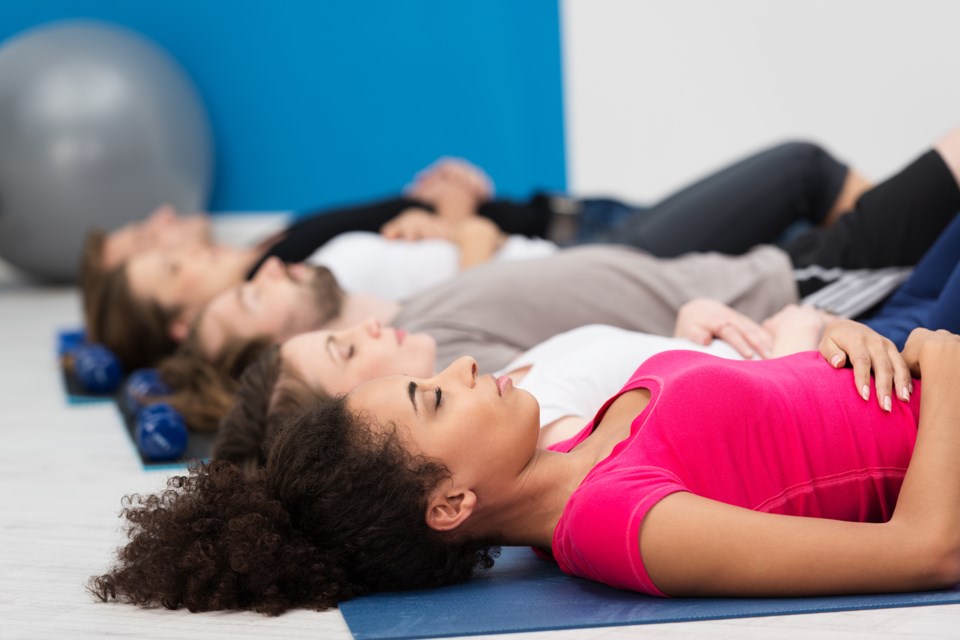Back pain can occur from exercise, work or conversely, from sitting too long. Eighty per cent of us will experience lower back discomfort at some point in our journey and chronic low back pain is estimated to cost the Canadian economy up to $60 billion annually in lost productivity.
There are two things that you can safely and immediately begin doing that will help lower back health. They are free and can often bring immediate relief. To read recent research on this approach, please see this.
#1: Breathe!
Breathing is a full and dynamic way that mobilizes all your core muscles. This elastic and tensile system works best when it is constantly engaged. Tightening core muscles (such as holding in your belly to look thinner) actually weakens the muscles. Naturally, breathing muscles contract and relax with each inhale/exhale cycle, providing a perfect and organic system for strengthening your core.
How to:
Lie comfortably on a firm surface. If getting to the floor is impossible, your bed will do. Shift and adjust until your spine is as neutral as possible and you are relatively comfortable. It is normal for your back to feel stiff and resistant at first. Try holding this position for one minute and continue with the breathing. If you are still so distracted by pain, try this lying on your side with the bolster (blankets or pillows) between your knees. For the breathing, start by just noticing your natural breath. Don’t change anything. Notice if your body moves at all when you breathe naturally. Does the belly or chest move more, or at all? Which moves first? How long is your exhale? How long is your inhale? Breathing happens automatically and is therefore a window to that normally hidden interior landscape.
Back pain really aggravates that inner world so that normal everyday occurrences wear you out faster. Very gradually, begin matching the length of the inhale to the length of the exhale. A common pattern is four seconds in and four seconds out. Try this for a minute or two, counting in your mind. Now add one second to each side. How does that feel? If doing fine, add one more second to each inhale and exhale. How does that feel? Continue breathing and counting in your own mind for about 20 – 30 breaths (or approx. 5 minutes). Repeat every day, ideally two times per day for a week. Evaluate your overall level of pain and perhaps increase the “dose” to 10 minutes per session.
#2: Stretch
Less is definitely more. A sore back likely means that you have overworked a muscle(s) somewhere so the last thing you need is attacking it with vigour to stretch it some more. Please go very gently into these stretches and take your time. It’s okay if you don’t feel a lot happening. These stretches should not produce strong sensation. It is best to begin with the breathing exercise noted above and continue that regulated breath throughout.
Use a firm chair and sit a bit forward. Plant both “sitting” bones firmly into seat. Lengthen spine upward so your back is neutral, not hunched forward. Keep the spine like this as you lift one leg over the other, as shown. If your knee hurts, stop; skip this stretch. If your knee is not level with the other one (as this model is showing), stay upright and breathe for one minute. Only if your knee is level with the other one and you are comfortable, slightly bend forward at the hip joints, keeping the back neutral. Do not round forward to try and “get more stretch." The model is looking forward past her legs, not back at her torso. Repeat other side.
Notice the back leg (foot on the floor) is slightly behind the buttock. This provides a careful stretch to the hip flexor. Press both feet down, one into the floor and one into the chair. Both feet are facing forward and are parallel to each other. The lifted knee is pointing straight forward. Keep spine erect. Breathe as per the previous exercise for one minute per side.
In this seated twist, the spine again remains upright. The shoulders relax away from the ears and the knees are parallel to each other. Breathe for one minute per side.
Perform these stretches two times per day. It will take less than 10 minutes.
This program will get you moving again and provides many side benefits such as feeling calmer and more energized. For more information on group classes focusing on this method, please consult www.yogacentreniagara.com or review online videos demonstrating related practices.



